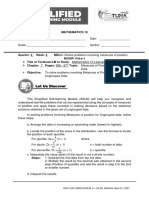Investment Appraisal PDF
Investment Appraisal PDF
Uploaded by
Hazwan JamhuriCopyright:
Available Formats
Investment Appraisal PDF
Investment Appraisal PDF
Uploaded by
Hazwan JamhuriOriginal Description:
Original Title
Copyright
Available Formats
Share this document
Did you find this document useful?
Is this content inappropriate?
Copyright:
Available Formats
Investment Appraisal PDF
Investment Appraisal PDF
Uploaded by
Hazwan JamhuriCopyright:
Available Formats
Investment appraisal
http://www.thestudentroom.co.uk/wiki/revision:investment_appraisal
PAYBACK
Works out how long it takes to repay the initial investment. e.g. Investment A. costs 100. Annual return of 25 Length 5 years YEAR 0 1 2 3 4 5 NET CASH FLOW CUMULATIVE CASH FLOW (ANNUAL RETURN) (CASH IN FLOW) -100 -100 25 -75 25 -50 25 -25 25 0 25 25
Payback is 4 years.
Sometimes it is necessary to calculate the month of payback when the figure is reached part way through the year. To do this you would you use formula:
ADVANTAGES
Easy to calculate Easy to understand Most relevant to businesses with cashflow problems Emphasises speed of return good in rapidly changing markets
DISADVANTAGES
Ignores money received after payback Can be difficult to establish a target payback period Doesnt consider the future value of money Short term approach
AVERAGE RATE OF RETURN
Compares profit with money invested.
To work this out, break it down into stages.
Calculate lifetime profit = total inflows outflow Divide by the number of years Use the formula
e.g. Investment A cost 100 25 return for 5 years
1. Inflow outflow 125 - 100 = 25
2. Divide by the number of years. 25/5 = 5
3. Use formula 5 / 100 X 100 = 5% return
ADVANTAGES
Percentage provides easy comparisons across projects Shows the profitability of a project
DISADVANTAGES
Harder and more time consuming Ignores time value of money
NET PRESENT VALUE (DISCOUNTED CASH FLOW)
This takes into account the time value of money. It is based on the principle that money is worth more than it is in the future. The principle exists for two reasons:
Risk money in the future is uncertain Opportunity cost Money could be in an interest account earning interest.
Discounting
This is the process of adjusting the value of money from its present value to its value in the future. The key to discounting is the rate of interest. The business chooses the most appropriate rate for the life of the project. It then identifies the discounting factor. The amount of money is then multiplied by the discounting factors to convert it to its net present value.
e.g. Project A 100 25 return 5 years
YEAR NET RETURN DISCOUNT FACTOR NET PRESENT VALUE 0 -100 0 -100 1 25 0.952 23.8 2 25 0.907 22.675 3 25 0.864 21.6 4 25 0.823 20.575 5 25 0.784 19.6 = 108.25
108.25 MINUS INITIAL COST (100) = 8.25 Profit = 8.25
ADVANTAGES
Considers the time value of money Reducing discounting rate reduces future monies more heavily Only one method that gives a definitive answer Positive return it is worth doing
DISADVANTAGES
Time consuming More difficult to understand Based on an arbitrary choice of interest rate
You might also like
- Introduction To Hook-Up & CommissioningDocument25 pagesIntroduction To Hook-Up & CommissioningHazwan Jamhuri100% (5)
- Optimization Methods in Asset Management FAQsDocument10 pagesOptimization Methods in Asset Management FAQsNITIN MISHRA100% (1)
- Guide to Contract Pricing: Cost and Price Analysis for Contractors, Subcontractors, and Government AgenciesFrom EverandGuide to Contract Pricing: Cost and Price Analysis for Contractors, Subcontractors, and Government AgenciesJohn E. Murphy CPA, CPCMNo ratings yet
- Slides of NPV, Free Cash Flow, Sensitivity Analysis Project DecisionsDocument57 pagesSlides of NPV, Free Cash Flow, Sensitivity Analysis Project DecisionsSebastian GorhamNo ratings yet
- Sharyngol JSC - BBDocument19 pagesSharyngol JSC - BBUrtaBaasanjargalNo ratings yet
- Practical FileDocument4 pagesPractical FileSeema RahulNo ratings yet
- Capital Budgeting Techniques PDFDocument57 pagesCapital Budgeting Techniques PDFraj100% (1)
- IPAA 2008-2009 HandbookDocument132 pagesIPAA 2008-2009 HandbookcopperheadpaNo ratings yet
- Hydrogen Case StudyDocument6 pagesHydrogen Case Studylhoerburger.ieu2023No ratings yet
- MIGADocument19 pagesMIGAKartikNo ratings yet
- R26 Understanding Cash Flow Statements Q BankDocument19 pagesR26 Understanding Cash Flow Statements Q BankCarlos Jesús Ponce AranedaNo ratings yet
- Bioinformatics Databases: Intellectual Property Protection StrategyDocument8 pagesBioinformatics Databases: Intellectual Property Protection StrategyHimanshu RajaNo ratings yet
- How To Display An Image in Devexpress XtraGrid Control Using C# andDocument2 pagesHow To Display An Image in Devexpress XtraGrid Control Using C# andMadheSatyawanNo ratings yet
- Chapter 14Document2 pagesChapter 14jhouvanNo ratings yet
- Crowdsourcing White Paper For PenserraDocument19 pagesCrowdsourcing White Paper For PenserratshepisonkoanaNo ratings yet
- Properties of Oilfield WatersDocument7 pagesProperties of Oilfield WatersMaisam AbbasNo ratings yet
- Focus On The Mining SectorDocument2 pagesFocus On The Mining Sectortami_abadiNo ratings yet
- Chapter 02 Investment AppraisalDocument3 pagesChapter 02 Investment AppraisalMarzuka Akter KhanNo ratings yet
- Case Study Analysis: Chestnut FoodsDocument7 pagesCase Study Analysis: Chestnut FoodsNaman KohliNo ratings yet
- Azteca Milling 2-2Document12 pagesAzteca Milling 2-2api-301267735No ratings yet
- ChemPlantDesign-General Plant ConsiderationDocument32 pagesChemPlantDesign-General Plant ConsiderationAiman SyazwanNo ratings yet
- Passing A DevExpress PivotGrid Value To A DotSpatial Map ControlDocument2 pagesPassing A DevExpress PivotGrid Value To A DotSpatial Map ControlAndy Obregon100% (1)
- TMAA Annual Report 2011FDocument51 pagesTMAA Annual Report 2011Fsaisridhar99No ratings yet
- c1 Statement of The Problem, Objectives of The Study (Subject To Changes) 2.0Document4 pagesc1 Statement of The Problem, Objectives of The Study (Subject To Changes) 2.0Polar GonzalesNo ratings yet
- Calculate Project ROI Using NPV, IRR and Packback PeriodDocument5 pagesCalculate Project ROI Using NPV, IRR and Packback PeriodsapsrikaanthNo ratings yet
- Week 10-Principles of Capital BudgetingDocument32 pagesWeek 10-Principles of Capital BudgetingAlok VermaNo ratings yet
- Metals Sector - Value ChainDocument11 pagesMetals Sector - Value ChainAmitOtwaniNo ratings yet
- General Geology of The Mississippi EmbaymentDocument32 pagesGeneral Geology of The Mississippi EmbaymentAhmadLukmanNurKarimNo ratings yet
- ProspectusDocument254 pagesProspectusSourav RoyNo ratings yet
- Study and Briefly Explain On: Accounting Concepts AssumptionsDocument4 pagesStudy and Briefly Explain On: Accounting Concepts AssumptionsAziz AhmadNo ratings yet
- Intellectual Property Rights and Protection ProcessDocument10 pagesIntellectual Property Rights and Protection ProcessHamza Ebrahimji100% (1)
- Amc Contract TermsDocument10 pagesAmc Contract TermsSenthil RNo ratings yet
- 2.0 Asset EvaluationDocument22 pages2.0 Asset EvaluationPrime ShineNo ratings yet
- Session 2 - Day 1Document63 pagesSession 2 - Day 1mayorladNo ratings yet
- Wind Energy Supplier Pitch DeckDocument64 pagesWind Energy Supplier Pitch DeckBerita DinpusNo ratings yet
- Weighted Average Cost of Capital WorksheetDocument2 pagesWeighted Average Cost of Capital WorksheetImperoCo LLCNo ratings yet
- Economic Consequences of Peak Oil For The Major Multinational Oil and Gas Companies (Amate 2018)Document19 pagesEconomic Consequences of Peak Oil For The Major Multinational Oil and Gas Companies (Amate 2018)Cliffhanger100% (1)
- Kear 2004 - Mine Project Life CycleDocument4 pagesKear 2004 - Mine Project Life CycleedatgkaNo ratings yet
- Operational Excellence Through Qualification and Global Knowledge TransferDocument17 pagesOperational Excellence Through Qualification and Global Knowledge TransferaakashtrivediNo ratings yet
- August Investor Presentation FINALDocument84 pagesAugust Investor Presentation FINALblast firstNo ratings yet
- Royal Dutch Shell Valuation As of December 3, 2018Document35 pagesRoyal Dutch Shell Valuation As of December 3, 2018KevinNo ratings yet
- Session 2 Discounted Cash Flow ValuationDocument39 pagesSession 2 Discounted Cash Flow ValuationSiddharth Shankar BebartaNo ratings yet
- 3 Ways M&a Is Different When You'Re Acquiring A Digital CompanyDocument5 pages3 Ways M&a Is Different When You'Re Acquiring A Digital CompanyjohannaNo ratings yet
- Trey Kelly Letter To TVA Board, February 14, 2023Document2 pagesTrey Kelly Letter To TVA Board, February 14, 2023Eric McErlainNo ratings yet
- Project Controls Manager in New York City Metro Resume Duncan ForsythDocument6 pagesProject Controls Manager in New York City Metro Resume Duncan ForsythDuncan ForsythNo ratings yet
- Assignment - 2 Cash Flow Analysis: Submitted by Group - 8Document13 pagesAssignment - 2 Cash Flow Analysis: Submitted by Group - 8dheeraj_rai005No ratings yet
- Demonstrating Value in Employee Recognition Programs: Why VOI Is The New ROIDocument5 pagesDemonstrating Value in Employee Recognition Programs: Why VOI Is The New ROIgenerationpoetNo ratings yet
- FMA Cash Flow StatementsDocument19 pagesFMA Cash Flow Statementskanha PanigrahyNo ratings yet
- CE 309 CAPITAL INVESTMENT DECISIONS Sept 27 2013Document46 pagesCE 309 CAPITAL INVESTMENT DECISIONS Sept 27 2013kundayi shavaNo ratings yet
- Capital Budgeting: Should We Build This Plant?Document51 pagesCapital Budgeting: Should We Build This Plant?Amit VijayvargiyaNo ratings yet
- GGG Ibex Contractor Financier Solar Power Mou 2 9 2015v01Document6 pagesGGG Ibex Contractor Financier Solar Power Mou 2 9 2015v01Shaquille O'Rion-Kush Simmons100% (1)
- Basic of Real Estate InvestmentDocument3 pagesBasic of Real Estate InvestmentNikky MinaNo ratings yet
- Dickinson - Suczek (1979)Document19 pagesDickinson - Suczek (1979)Laura Valentina Laguna ValenciaNo ratings yet
- Renewable Energy Development in Trinidad and Tobago: Neisha Maria Therese ManickchandDocument74 pagesRenewable Energy Development in Trinidad and Tobago: Neisha Maria Therese ManickchandDetlef LoyNo ratings yet
- Oil and Gas Industry PDFDocument7 pagesOil and Gas Industry PDFGabriela MaerskNo ratings yet
- Mergers and Acquisitions (M&as) in The Nigerian BankingDocument10 pagesMergers and Acquisitions (M&as) in The Nigerian BankingRitji DimkaNo ratings yet
- Bioleaching of Arsenic in A Drinking Water Treatment PDFDocument11 pagesBioleaching of Arsenic in A Drinking Water Treatment PDFAnand MathewNo ratings yet
- Concept of Capital Budgeting: Capital Budgeting Is A Process of Planning That Is Used To AscertainDocument11 pagesConcept of Capital Budgeting: Capital Budgeting Is A Process of Planning That Is Used To AscertainLeena SachdevaNo ratings yet
- Coca-Vs-Pepsi-Fin-Analysis - Sent OutDocument6 pagesCoca-Vs-Pepsi-Fin-Analysis - Sent OutChinh Le DinhNo ratings yet
- 3.NPER Function Excel Template 1Document9 pages3.NPER Function Excel Template 1w_fibNo ratings yet
- A Guide To State Oil & Gas Regulatory Entities in The SouthDocument48 pagesA Guide To State Oil & Gas Regulatory Entities in The SouthVikas YamagarNo ratings yet
- Fundamentals of Petroleum Refinery EconomicsDocument2 pagesFundamentals of Petroleum Refinery EconomicsFahrizal RifkiNo ratings yet
- Case Study PneumaticDocument16 pagesCase Study PneumaticHazwan Jamhuri100% (7)
- Mec600 Assignment October 2013Document2 pagesMec600 Assignment October 2013Hazwan Jamhuri100% (1)
- Impulse TurbineDocument15 pagesImpulse TurbineHazwan JamhuriNo ratings yet
- Hazwan Curriculum VitaeDocument1 pageHazwan Curriculum VitaeHazwan JamhuriNo ratings yet
- Firstname Lastname: Sample Resume - High School - No Work ExperienceDocument1 pageFirstname Lastname: Sample Resume - High School - No Work ExperienceHazwan JamhuriNo ratings yet
- 08 StringDocument14 pages08 StringdarshanNo ratings yet
- Text Generation With Gan Networks Using Feedback ScoreDocument14 pagesText Generation With Gan Networks Using Feedback ScoreJames MorenoNo ratings yet
- Algorithm Question SetDocument26 pagesAlgorithm Question Setlokenders80175% (4)
- Activity Sheets in Math 6 - Third QuarterDocument4 pagesActivity Sheets in Math 6 - Third QuarterJackylyn Evangelista100% (5)
- Applied Numerical MethodsDocument1 pageApplied Numerical MethodsAbhinav RajmohanNo ratings yet
- Block Diagram Algebra PDFDocument29 pagesBlock Diagram Algebra PDFAman SinghNo ratings yet
- Honors Final PaperDocument14 pagesHonors Final Paperapi-284297723No ratings yet
- Stress Measurement of A Helical Coil Spring Under Static Load Using Strain RosetteDocument7 pagesStress Measurement of A Helical Coil Spring Under Static Load Using Strain RosetteSuresh KumarNo ratings yet
- Kinetic Modelling of A Pyrolysis - Gasification Reactor: Chemical EngineeringDocument6 pagesKinetic Modelling of A Pyrolysis - Gasification Reactor: Chemical Engineeringsandra-meriem.mokliNo ratings yet
- Building Blocks of UML: Object Oriented Design and AnalysisDocument43 pagesBuilding Blocks of UML: Object Oriented Design and AnalysisSeYy FuhiNo ratings yet
- Chapter - 5: Economical & Physical Justification For CanalsDocument69 pagesChapter - 5: Economical & Physical Justification For CanalsMahmoud I. MahmoudNo ratings yet
- Assembly Language Basics PresentationDocument47 pagesAssembly Language Basics PresentationlockpeNo ratings yet
- Chapter-13 Limits and DerivativesDocument67 pagesChapter-13 Limits and DerivativesDaksh ChothaniNo ratings yet
- Maths Class Xii Sample Paper Test 11 For Board Exam 2023 AnswersDocument14 pagesMaths Class Xii Sample Paper Test 11 For Board Exam 2023 AnswersOm ZambareNo ratings yet
- A Date With Data - Methods of Presenting DataDocument29 pagesA Date With Data - Methods of Presenting DataDarryl Mark LapuzNo ratings yet
- Logic Gates P&D PDFDocument4 pagesLogic Gates P&D PDFBrandon RamkissoonNo ratings yet
- Derivation of Pressure Loss To Leak Rate Formula From The Ideal Gas LawDocument3 pagesDerivation of Pressure Loss To Leak Rate Formula From The Ideal Gas Lawsatheez3251No ratings yet
- American Psychological Association (APA) GuideDocument14 pagesAmerican Psychological Association (APA) GuideDedi Ariwibowo0% (1)
- Recommendations of Fastener Flexibility Using FE p3Document16 pagesRecommendations of Fastener Flexibility Using FE p3Ludovic MoutienNo ratings yet
- Pentagonal RelationshipsDocument6 pagesPentagonal RelationshipsDanny KahnNo ratings yet
- Linear Programming ExercisesDocument147 pagesLinear Programming ExercisesScribdTranslationsNo ratings yet
- Anushka COADocument4 pagesAnushka COAanushkaanand2021No ratings yet
- Model and Observer-Based Controller Design For A Quanser Helicopter With Two DOFDocument5 pagesModel and Observer-Based Controller Design For A Quanser Helicopter With Two DOFosdacavNo ratings yet
- (AMS - MAA Textbooks Volume 39) Campbell, Duff - An Open Door To Number Theory-Mathematical Association of America (2018)Document297 pages(AMS - MAA Textbooks Volume 39) Campbell, Duff - An Open Door To Number Theory-Mathematical Association of America (2018)Minh TuấnNo ratings yet
- Math10 Q4 Week 4-SSLMDocument4 pagesMath10 Q4 Week 4-SSLMJumar MonteroNo ratings yet
- G117-13 (Withdrawn 2016)Document6 pagesG117-13 (Withdrawn 2016)Hadi HowaidaNo ratings yet
- Datapoint TypesDocument187 pagesDatapoint TypeslrdseekerNo ratings yet
- Class 8 Chapter 2 Maths Important FormulasDocument3 pagesClass 8 Chapter 2 Maths Important Formulasdheerajchoudhary116No ratings yet































































































